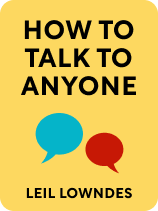

This article is an excerpt from the Shortform book guide to "How to Talk to Anyone" by Leil Lowndes. Shortform has the world's best summaries and analyses of books you should be reading.
Like this article? Sign up for a free trial here .
Do you want to learn how to have a deep conversation with anyone? How can you move beyond superficial topics and talk about things that are more personal and profound?
If you want to move beyond superficial conversations, you’re going to have to build an emotional connection with your conversation partner. To put it simply, emotional connection is when people trust each other enough to reveal more about themselves—who they are and how they really feel about things. It’s at this stage that conversations move from being superficial to being meaningful.
She suggests four techniques to help build trust so that you can develop an emotional connection.
#1: Make Your Interest in Them Clear
In her book How to Talk to Anyone, communications expert Leil Lowndes explains how to have a deep conversation with anyone. The first step, she says, is to make your interest in them clear. To that end, ask them questions to learn more about how they spend their time and give them space to talk about themselves. Then mention how much you enjoy listening to them and find a way to relate your own interests to theirs. According to Lowndes, this approach will endear them to you because it signals that you’re interested in who they are and what they care about.
Remember details for future conversations: Write down interesting facts about the people you talk to so that you can refer to them the next time you meet them. Alluding to things that they’ve previously shared about themselves instantly makes them want to reveal even more—because it demonstrates that you’ve been paying attention to them and care enough to remember little details.
#2: Present a Positive Image of Yourself
Be conscious of revealing your flaws. Many people assume that they can make themselves appear more endearing by throwing in self-effacing remarks. However, Lowndes argues, this tactic produces different effects depending on your professional or social status.
- If you’re higher in status (for example, if you’re talking to your employee), this tactic can humanize you and put the other person at ease.
- On the other hand, if you’re lower in status (for example, if you’re talking to the CEO of a company you want to work for), this tactic reduces your credibility because your conversation partner doesn’t know you well enough to put your flaws in context.
Therefore, Lowndes argues, you should think carefully about your status and how positively or negatively others will perceive you before resorting to this common tactic.
#3: Maintain a Positive Image of Them
Focus your attention only on the good things about them. Don’t put them down or make jokes at their expense. Likewise, don’t draw attention to their faults—for example, if they fumble in some way or say something inappropriate. Instead, do your best to make them feel comfortable and accepted for who they are. According to Lowndes, the more you focus on their good qualities, the more they’ll appreciate you for seeing the best in them.
One way to put this into practice is to give genuine compliments. Think about what you’re learning about them and what they seem to care about and use complimentary statements to uplift them. This will make them feel appreciated and will encourage them to continue talking. For example, if they’ve been discussing parenthood, say something like, “Well, it sounds like your children are lucky to have you.”
#4: Foster Empathy Using Mirroring
According to Lowndes, people feel more comfortable revealing the truth about themselves to those who seem to be just like them—those who share similar traits, interests, and values. She suggests that you can encourage people to believe that you’re just like them by adopting the following four tactics.
- Tactic #1: Match Their Mood. Show that you empathize with their emotions by tuning into their mood and matching their tone and pace. This will make them feel like you’re on the same wavelength as them. For example, if they talk quickly because they’re excited about something, try to maintain that high when you speak.
- Tactic #2: Repeat Their Words Back to Them. Listen to the specific words they use and echo them back when it’s your turn to speak. Finding ways to incorporate their vocabulary into what you say will make them believe you share their values and think like them.
- Tactic #3: Make Supportive Statements. Show that you understand what they’re feeling by using short empathetic statements that match the senses they use to express them. For example, if they talk about how they saw something, you could say, “I see what you mean.” If they talk about how they felt about something, you could say, “I understand how you feel.” These short sentences will make them believe that you interpret the world in the same way that they do and will encourage them to continue. Additionally, this tactic helps to keep the conversation flowing if you find yourself at a loss for words.
- Tactic #4: Use “We,” “Us,” and “Our” to Imply Friendship. Create a feeling of connection and intimacy by using language that presupposes that you’re already friends. When people are in a close relationship, they automatically refer to themselves with words that unite them, such as “we” and “us.” Using these words tricks others into believing that you’re already friends. For example, instead of saying, “I’m going to find some food,” say, “Shall we find some food?”

———End of Preview———
Like what you just read? Read the rest of the world's best book summary and analysis of Leil Lowndes's "How to Talk to Anyone" at Shortform .
Here's what you'll find in our full How to Talk to Anyone summary :
- Practical techniques to help you overcome social discomfort
- How to confidently develop new connections
- How to appear more likable without saying a word






